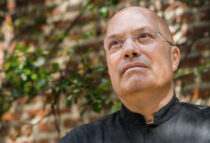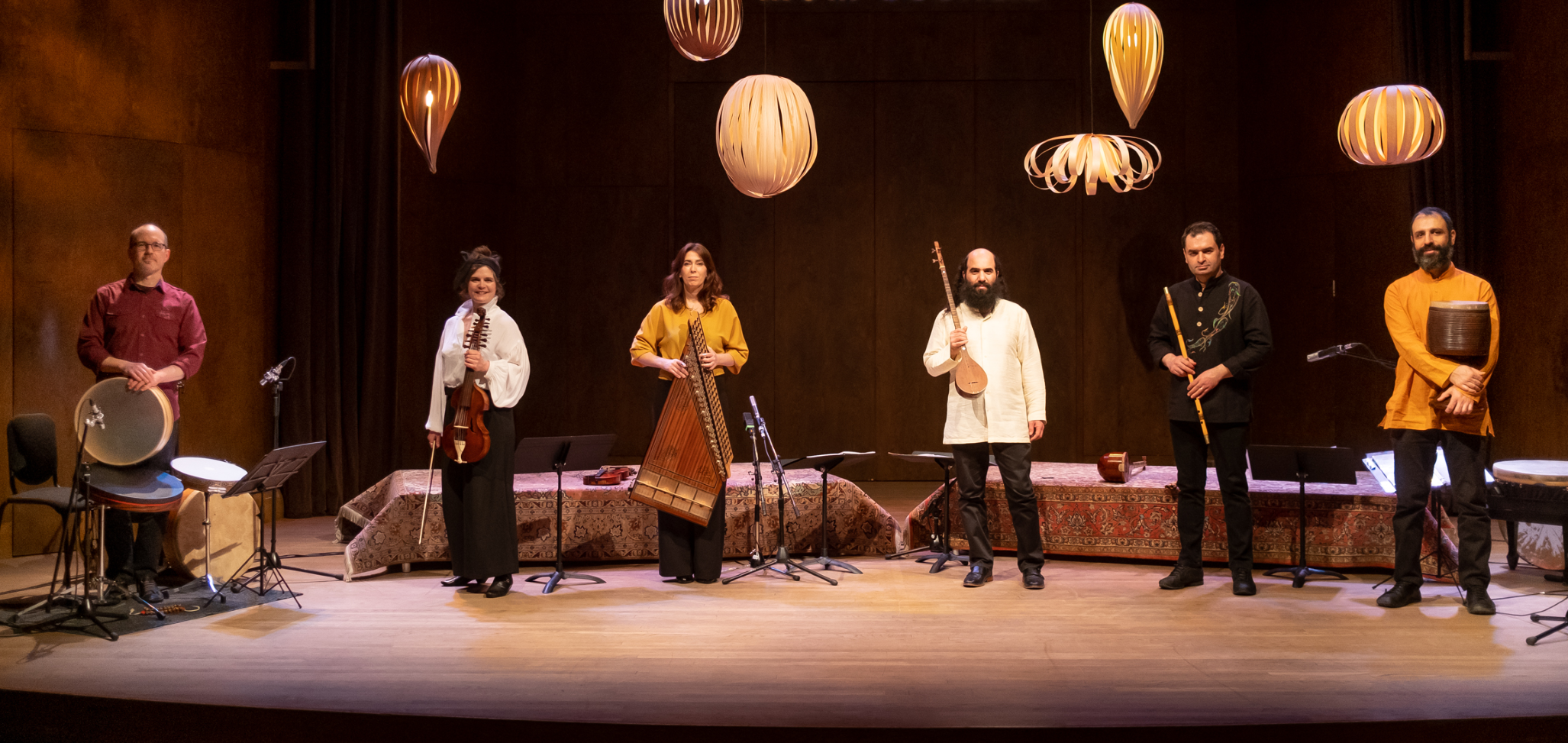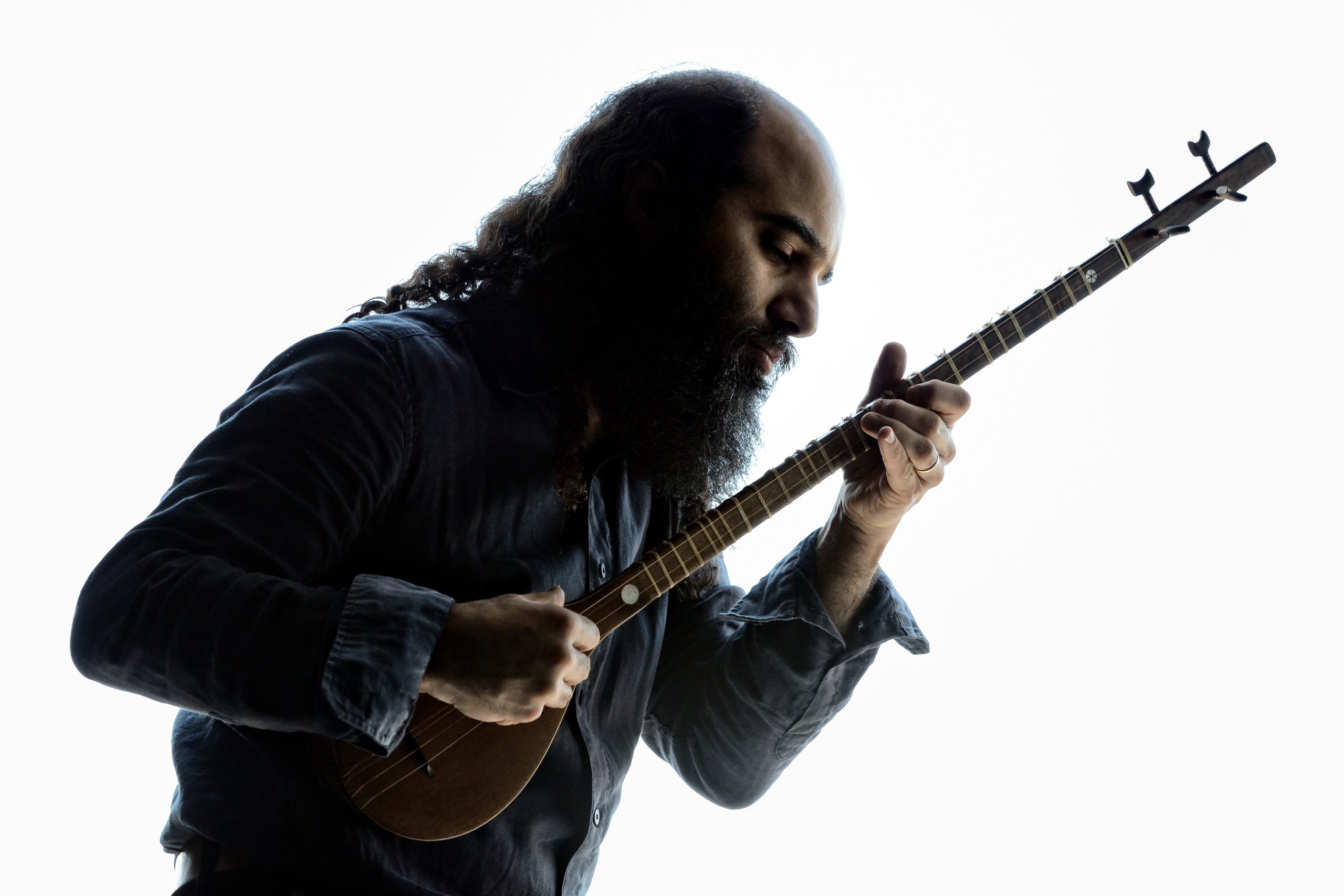Christ Church Cathedral
Pre-Concert Talk | 7 p.m. : Kiya Tabassian & Marco Beasley, hosted by Suzie LeBlanc
Artists: Marco Beasley, tenor and Constantinople directed by Kiya Tabassian
Marco Beasley, a leading figure in Renaissance music, joins Constantinople under the direction of Kiya Tabassian, to immerse us in the audacious, imaginative world of Leonardo da Vinci’s drawings. In 1502 da Vinci drafted the plans for a bridge in Constantinople (now Istanbul) that was to span the Bosporus, but it was never built. A continuation of their journey tracing the footsteps of great visionaries, this concert celebrates the originality of an artist and scientist who left a profound mark on the history of humankind and builds the bridge he envisioned between East and West.
This concert is generously sponsored by Fran Watters & Paul Devine
Thank you to East India Carpets for supplying the carpets for this performance.
PROGRAMME
Kuh-Pareh
Agha Mo’men (16th c.), Cantemir Collection
Non val aqua al mio gran foco
Bartolomeo Tromboncino (1470-1535 or later), Libro II, Franciscus Bossinensis, Fossombrone, 1511
Staralla ben cussì
Anonymous (16th c.), Libro II, Franciscus Bossinensis, Fossombrone, 1511
Parvaz
Kiya Tabassian (1976), text by Amir Khusrow (1253-1325)
Pan de miglio caldo
Anonymous (16th c.), Libro VI, Petrucci, Venice, 1505
Saltarello e Piva
Ambrogio Dalza (?-1508), Intabolatura… libro II, Petrucci, Venice, 1508
Sera ne lo cor mio
Anonymous (15th c.), MS Sevilla, Colombina 5-l-43
Tu dormi
Bartolomeo Tromboncino, additional lyrics by Marco Beasley (1957), Libro I, Franciscus Bossinensis, Venice, 1509
Rouz o Shab
Kiya Tabassian, text by Rumi (1207-1273)
So stato nel inferno
Anonymous (15th c.), text by Feo Belcari, MS Sevilla, Colombina 5-l-43
Pishrow Kürdi
Sultan Korkut (1467-1513), Macmua-i Saz u Suz
Semai Pire mey foroush
Anonymous (15th c.), text by Hafiz (1320-1390), Macmua-i Saz u Suz
Cavalca Sinisbaldo
Anonymous (16th c.), MS Sevilla, Colombina 5-l-43
Hijaz Semai
Anonymous Persian (16th c.), Macmua-i Saz u Suz
Noi che semper naveghemmu
Anonymous Genovese (15th c.), text edited by Gian Piero Alloisio (1956)
Golestan
Anonymous Persian (16th c.), Cantemir Collection
TEXTS AND TRANSLATIONS
Click here to read the texts and translations.
PROGRAMME NOTES
In these times where the air is always heavy with foul smell of war and conflicts, it is more important than ever to build and recreate bridges between civilizations, cultures and peoples. Bridges that encourage us to come together and to reconcile, bridges that call for dialogue and conversation, for a synergy of ideas and actions that will help us to live and build better together. This is no longer just an ideal or a utopian vision of humanity, but a real and desperate need that keeps growing every day.
Building musical bridges between traditions is at the very core of Constantinople, the ensemble we founded over twenty years ago. This is the mission we are dedicated to pursuing, the principle that guides us: to explore music from today and from times long past, from here and from faraway places.
The bridge imagined by Leonardo da Vinci was the spark that ignited this musical program. The music of the two cultural spheres he sought to connect with this impressive work of architecture enters into dialogue here, creating a unique and expressive soundscape that brings the bridge he dreamed about to life.
Together with my colleague and dear friend Marco Beasley we have made a careful selection of compositions – inspiring, musical, poetic – from the time of Leonardo da Vinci. The foundation of our bridge is made up of pieces and poems taken from manuscripts and printed works of the era: from Italian frottole from the 15th and 16th century to Genovese songs, from Ottoman instrumental compositions to Persian poems by Hafez, Rumi and Amir Khosrow. We then navigated between these works, defining their stylistic boundaries in order to find the passageways between them and to create a true encounter and dialogue which goes beyond a mere juxtaposition of repertoire.
And so the bridge imagined and drawn over 500 years ago by the genius Leonardo da Vinci has now been redrawn and erected in music and song through the human and artistic encounter that took place between the eight musicians who contributed to this project. It is our hope that this bridge will be travelled and crossed many times by you, who listen to this recording, and by the inhabitants of both shores.
- Kiya Tabassian
A Bridge Between Two Worlds
I, your faithful servant, understand that it has been your intention to erect a bridge from Galata to Stambul… but this has not been built because you have found no experts. I, your subject, am able to do it. I will also build a drawbridge so that it will be possible to reach the coast of Anatolia. If Gods wants it, please believe my words, and consider me your servant, always at your disposal…
On the 3rd of July of the year 1502 a remarkable letter with a bold and daring proposal sailed on a ship from Genova to Istanbul. It was directed to Sultan Bayezid II, and signed off by one of the most brilliant minds of his time: the painter, engineer, architect and scientist Leonardo da Vinci.
In his letter, Leonardo proposes the Sultan to build no less than two bridges. The first bridge was to cross the Golden Horn and thus connect the Ottoman city with the district of Galata, a bustling hub for Venetian, Florentine and Genovese merchant communities vying for the best trade deals with the Orient. The second was even more ambitious: this ingenuous drawbridge was to cross the Bosphorus and thus effectively connect two continents, two vastly different worlds: Europe and Asia.
How did the Italian polymath come to offer his services to an Ottoman ruler? Leonardo’s life coincided with a fascinating episode of Ottoman-Italian relations. In 1453, just one year after he was born, Constantinople had been conquered by the Turks and become the capital of a rapidly expanding Ottoman empire. This new world order led to fierce and ongoing battles, but also to intense diplomatic exchanges and a lively flux of people, art and ideas.
The first Sultan Mehmed II had a cosmopolitan outlook and a great passion for Italian painting, sculpture and architecture. At his frequent requests, many Italian artists, most famously the Venetian painter Gentile Bellini, travelled to his palace court in Istanbul. His successor Bayezid II had a keen interest in ‘le arti meccaniche’, especially in Italian innovations in engineering and technology. And so it does not surprise that when he conceived a desire to bridge the Golden Horn, the news spread to his Ottoman delegates in Venice and eventually also reached Leonardo.
To Leonardo, always on the lookout for new horizons and opportunities, such a challenge must have been irresistible. His proposals, of which a sole drawing survives in his notebooks, were clearly meant to impress: one bridge, soaring 40 meters above sea level, so high that ships in full sail were still able to pass through, the other so long that it would have been the largest bridge in history at the time – if it had been built. The Sultan however seems to have found his plans too ambitious: Leonardo’s letter remained unanswered, and his design remained no more than an idea: it would take another three centuries before the waters of Constantinople were bridged.
- Marjolein Van Zuylen

Marco Beasley, tenor
Marco Beasley studied music at the University of Bologna where he deepened his knowledge of the two stylistic pivots of the late Renaissance – recitar cantando and sacred and secular polyphony. Following graduation he began an active concert career which has taken him to some of the most prestigious concert venues including the Mozarteum (Salzburg), the Concertgebouw (Amsterdam), the Accademia di Santa Cecilia (Rome) and the Lincoln Center (New York). In 1984, he co-founded Accordone together with Guido Morini and Stefano Rocco. Most recordings in his wide-ranging discography are with this ensemble. Since 2014 Marco has performed as a solo artist. His personal research into vocal production and the intelligibility of sung texts have earned him the praise of an ever-increasing public. In 2009, the Dutch Association of Theater and Concert Halls nominated him for Best Performer of the Year.

Ensemble Constantinople
Founded in 1998 by its artistic director Kiya Tabassian, Constantinople is a musical ensemble inspired by the ancient city straddling the East and West. Since its founding, the ensemble promotes the creation of new works incorporating musical elements of diverse musical traditions around the world; drawing from medieval manuscripts to a contemporary aesthetic, passing from Mediterranean Europe to Eastern traditions and New World Baroque. Underpinned by a spirit of research and creation, Constantinople has joined forces with leading international artists such as: Marco Beasley, Suzie LeBlanc, the Mandinka griot Ablaye Cissoko, the Greek ensemble En Chordais, the Belgian duo Belem, The Klezmatics, sarangi virtuoso Dhruba Ghosh, and Iranian kamancheh master Kayhan Kalhor. They are regularly invited to perform in international festivals and prestigious concert halls including: the Salle Pleyel (Paris), the Berliner Philharmonie, the Fes Festival of World Sacred Music (Morocco), the Rencontres musicales de Conques (France), the Aga Khan Museum (Toronto), the Cervantino Festival (Mexico) and the Festival de Carthage (Tunisia). Constantinople has 19 albums to its credit. Over the past fifteen years, Constantinople has created nearly 50 works and travelled to more than 240 cities in 54 countries.

Kiya Tabassian, music director
In 1990, at age 14, Kiya Tabassian emigrated with his family to Quebec from his native Iran, bringing with him some initial musical training in Persian music. Determined to become a musician and composer, he continued his education in Persian music, studying with Reza Gassemi and Kayhan Kalhor. At the same time, he studied composition at the Conservatoire de musique de Montréal with Gilles Tremblay. In 1998, he co-founded Constantinople with the idea of developing an ensemble for musical creation that draws from the heritage of the Middle Ages and the Renaissance, of Europe, and of the Mediterranean and the Middle East. Serving as its artistic director, Kiya has developed close to 40 programs with Constantinople. Numerous musical groups and institutions have called upon his talents as a composer, including the Orchestre symphonique de Montréal, the Nouvel Ensemble Moderne and the European Broadcasting Union. He has also composed music for documentary and feature films, including Jabaroot and Voices of the Unheard. Since the summer of 2017, he has held the post of Associate Artist at Rencontres musicales de Conques festival in France. In 2017 he co-founded the Centre des musiciens du monde in Montreal. Kiya also sits on the Board of Conseil des arts et des lettres du Québec.


